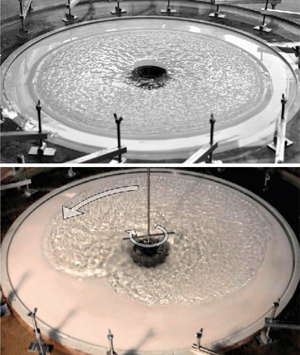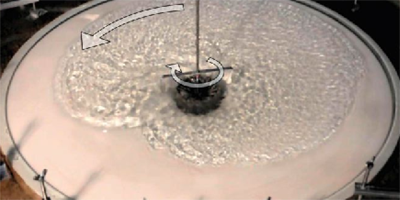Seeing Stellar Explosions with Shallow Water
Despite decades of intensive study, the mechanism whereby stars explode remains a mystery. The explosion is triggered when the iron core of a massive star gravitationally collapses to a newborn neutron star. When the gas in the inner core reaches nuclear densities, the equation of state stiffens, so the inner core abruptly stops collapsing and rebounds outward, which drives a strong outward-moving shock wave. Simulations show that the shock stalls at a radius of – km, forming a standing accretion shock through which outside material continues to pass as it falls onto the proto-neutron star (PNS) at a radius of tens of km. To produce the observed explosions, something must re-energize the shock so that it can pass through the star and unbind the outer layers. Identifying this “something” is the key problem in supernova theory. A related problem is the attempt to explain the spin and velocity distributions of neutron stars by the conditions of their births. In a novel attempt to understand the dynamics of the stalled accretion shock, Thierry Foglizzo at CEA-Saclay, France, and colleagues [1] report in Physical Review Letters their experimental analog based on the behavior of shallow water.
Researchers seeking to understand the explosion mechanism have often resorted to large-scale numerical hydrodynamics simulations that try to capture, at least approximately, the most promising shock-re-energizing processes, especially heating via absorption of the neutrinos radiating out of the PNS. Although the simulations disagree with each other in some respects, they all find that nonspherically symmetric fluid instabilities in and near the standing shock play a crucial role in the shock’s re-energization. Two-dimensional (axisymmetry) simulations made the unexpected discovery that the shock itself is unstable [2]. Perturbations quickly grow, so that the shock begins violently sloshing back and forth along the symmetry axis. This sloshing expands the shock overall and enlarges the region where heating via neutrinos occurs. Some simulations suggest this standing accretion shock instability (SASI) to be the key to successful explosions (e.g., Ref. [3]) and perhaps also provide an explanation for the initial “kick” that gives neutron stars their high observed velocities [4,5].
Three-dimensional simulations of the SASI yielded further surprises. Spiral SASI modes effect a separation of positive and negative angular momentum flows, so that even if the initial inflow has low angular momentum, the SASI can cause the gas at the shock to begin rotating while the gas accreted down toward the PNS preferentially rotates in the opposite sense [6]. This infalling gas hits the PNS and spins it up, a process that, together with the core’s initial angular momentum, is perhaps the leading influence on neutron star natal spins. Whether or not simulations have hit on the supernova explosion mechanism, they have brought attention to an intriguing hydrodynamic instability.
Of course, it is one thing to see something in a simulation and another to explain it. There are strong arguments, based on perturbation theory and comparisons with simulations, that the SASI is caused by the advective-acoustic cycle [7–9]. In the infalling flow there are acoustic (pressure) perturbations that propagate at the speed of sound, and there are perturbations of vorticity and/or entropy that advect along with the flow. In a uniform flow, these perturbations would not affect each other, but in the stalled shock system, they are coupled at the shock and inside the shock where the advected flow decelerates. The deceleration of the advected wave creates an acoustic wave traveling back up to the shock; the acoustic wave hitting the shock produces vorticity/entropy waves. The two processes combine in an unstable cycle.
Linear analysis sheds light on the cause of the instability, but other tools are needed to understand its nonlinear development and saturation. One would like to know how sensitive the SASI’s features are to the properties of the progenitor star or the simplifications of physics used by numerical models. One would also like to demonstrate that simulations with currently achievable numerical resolutions are faithfully capturing the instability. For these reasons, Foglizzo et al. have turned to an experimental approach [1]. Since the feedback process driving the instability seems to be fairly general, one would expect the SASI to be insensitive to the details of the gravitational potential, equation of state, or neutrino heating. (Indeed, similar instabilities have been identified in simplified accretion flows [7,10]) They therefore chose to construct a simple setup that contains only the major ingredients of the SASI: an inflow through a standing shock and some analog of advective and sound waves.
The Saclay team’s setup uses shallow water flows. Such flows can provide excellent analogs of hydrodynamical phenomena; the shallow water equations are mathematically equivalent to the equations for a gas with equation of state constant, i.e., an isentropic fluid with adiabatic index . Surface gravity waves are the analog of sound waves, and hydraulic jumps are the analog of shocks. The researchers injected water into a gravity well at a radius of cm where it flows inward toward a vertical cm pipe placed at the well’s center. Regular spilling of water down the pipe prevents accumulation and keeps the water’s surface at a constant level. A circular hydraulic jump forms at a radius of cm, separating shallow supercritical flow from deeper subcritical flow. The authors call their setup the SWASI: shallow water analog of a shock instability.
For large enough water inflow rates, the hydraulic jump in the SWASI does indeed develop an instability that shares many of the distinct properties of the SASI. Large nonaxisymmetric modes appear; both sloshing and spiral modes are seen. Also observed is the characteristic angular momentum separation; although the injected water is nonrotating, the hydraulic jump and interior inflowing water begin rotating in opposite senses (see Fig. 1 and Video 1). The mode oscillation period roughly matches that seen in supernova simulations when suitably scaled. The authors compare their observations with numerical simulations of the shallow water equations and a perturbative analysis, and find good agreement between all three.
Foglizzo et al. hope their experiment will provide a new tool for studying the hydrodynamic aspects of supernova physics. They plan to use the SWASI to better understand the SASI’s saturation mechanism. They also hope to modify the experiment to add angular momentum to the inflow as a model of the effects of stellar spin on the instability. Meanwhile, supernova simulations will continue to improve by additions that better capture the key physics: three dimensions, improved neutrino transport, general relativity, nuclear reactions, etc. Finally, in the coming decades, we may hope to witness another core-collapse supernova in or around our galaxy. Detections of neutrinos and gravitational waves from the heart of the explosion could help definitively settle the explosion mechanism.
References
- T. Foglizzo, F. Masset, J. Guilet, and G. Durand, Phys. Rev. Lett. 108, 051103 (2012)
- J. M. Blondin, A. Mezzacappa, and C. DeMarino, Astrophys. J. 584, 971 (2003)
- A. Marek and H.-T. Janka, Astrophys. J. 694, 664 (2009)
- L. Scheck, T. Plewa, H.-T. Janka, K. Kifonidis, and E. Müller, Phys. Rev. Lett. 92, 011103 (2004)
- J. Nordhaus, T. D. Brandt, A. Burrows, E. Livne, C. D. Ott, and Phys, Rev. D 82, 103016 (2010)
- J. M. Blondin and A. Mezzacappa, Nature 445, 58 (2007)
- T. Foglizzo and M. Tagger, Astron. Astrophys. 363, 174 (2000)
- L. Scheck, H.-T. Janka, T. Foglizzo, and K. Kifonidis, Astron. Astrophys. 477, 931 (2008)
- J. Guilet and T. Foglizzo, arxiv:1112.1427 (2011)
- T. Foglizzo, Astron. Astrophys. 392, 353 (2002)





